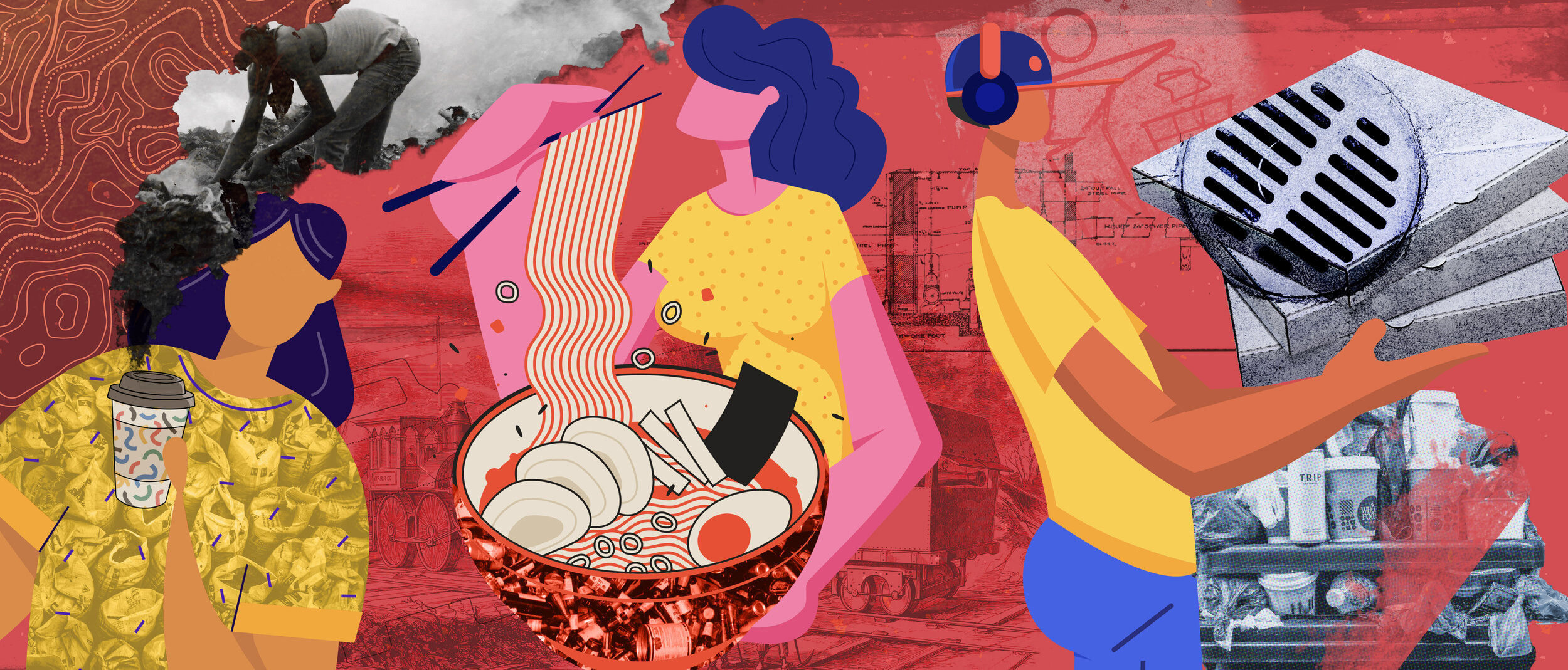
Food Delivery Is up During COVID-19, with Unintended Consequences for Health and the Environment
COVID-19 has transformed how we purchase and consume food prepared outside the home. Orb Media’s new reporting package addresses how to evaluate and mitigate some of the negative impacts of this global trend.
A rapid and sustained shift toward takeout, delivery and disposable tableware as a result of efforts to stem the virus’ spread has implications not only for our environment but also, paradoxically, our health.
Online meal delivery revenues in the United States are projected to reach $26.5 billion this year, a 20 percent increase from 2019. In the United Kingdom, 1 in 6 people ordered online food delivery through a third-party service in 2020, or about 25 percent more than last year.
Single-Use Packaging Sounds Safer but Could Make Us Sick
According to a newly published study and accompanying database from the Switzerland-based Food Packaging Forum, more than 12,000 different chemicals can potentially be used in food packaging, a third of which have not been studied for toxicity.
Some of the most commonly used chemicals in disposable products like takeout containers and plastic cutlery, including plastic additives and perfluorinated chemicals, are considered likely endocrine disruptors. Exposure to these types of chemicals, which interfere with humans’ hormonal systems, is associated with a wide range of adverse health effects, including increased susceptibility to COVID-19 and other bacterial and viral infections.
“Endocrine-disrupting chemicals weaken us in our COVID-19 battle.”
— Environmental Health News, April 23, 2020
Among other solutions, stricter regulation of food-contact chemicals is needed, says Jane Muncke, Managing Director of the Food Packaging Forum. “The manufacturers of these materials usually will tell you, ‘Our product complies with regulations.’ That’s a very reasonable statement and absolutely understandable as a manufacturer. For me, the definition of safety should be that it doesn’t contain hazardous chemicals, and it doesn’t contain untested chemicals. But with the current definition by regulations, it’s absolutely fine to have both hazardous and untested chemicals in the products.”
Widespread Environmental Consequences
Single-use foodware is also associated with significant environmental impacts. These include carbon emissions as well as land, water and chemical use throughout the product’s entire life cycle, from sourcing and manufacturing to transportation and disposal.
In light of the increased use of disposable food service ware during the pandemic, Orb Media has produced new resources to assist journalists and consumers in understanding and reporting on the consequences of this important issue:
Orb Media’s original methodology for assessing potential risks and impacts associated with any individual article of disposable foodware.
A list of preferred materials and products, from the five most common types of single-use products.
Leads and angles for local newsroom coverage.
Expert interviews for review and reuse.
A complete list of resources and references supporting Orb Media’s research, made available to media organizations around the world.
Disposable Food Packaging Use Is Up: A Consequence of COVID-19
Even as we anticipate the arrival of vaccines for COVID-19, and gain ever more knowledge about its spread and treatment, the virus and its impact on our world won’t disappear overnight. In fact, the pandemic could affect our lives and ways of eating for years to come.
But the increased use of disposables during the pandemic need not become another reason for despair. To the contrary, COVID-19 can be a catalyst for safer and more sustainable choices around disposable foodware. This includes avoiding disposables when possible, says Sue Chiang, Pollution Prevention Director for the US-based nonprofit Center for Environmental Health, which studies and advocates for chemical safety in a variety of areas, including food packaging.
Research has shown that when washed and handled properly, reusable containers made of glass, stainless steel and ceramic are just as sanitary and no more likely to spread the virus than disposables.
Even during the pandemic, experts like Chiang and Muncke have called for the development of new models and systems of managing reusable foodware.
When Going ‘Reusable’ Is Impossible, Recognize Risks and Opportunities
Where reusables are unfeasible, Chiang and Muncke encourage choosing the safest and most sustainable disposable food service ware available.
The pandemic can be a driver of innovation and investment in better systems, technologies and materials worldwide, Chiang says. “Now during COVID, there’s this opportunity. Everything has been disrupted, so there’s an opportunity to think about how we do the whole thing.”
Identifying potential chemical risks associated with different disposable food service articles is not a straightforward task. Many factors and variables are involved, with plenty of unknowns — including precisely which chemicals are present in the product, how harmful they may be, and the extent to which they will migrate or transfer, into food items or drinks.
Still, it is possible to make educated and informed assumptions based on what the product is made of, how it will be used, and additional information that can be found on manufacturer or product websites. Orb Media’s methodology is designed to facilitate this process by assessing the safety and sustainability of available materials and products, and ultimately encouraging the use of less-toxic, lower-impact options.
When We’re Not Careful, Chemicals Slip In
The worrisome link between molded fiber food packaging and highly perfluorinated chemicals, also known as per- and polyfluoroalkyl substances -- or PFAS (PEE-fas) for short -- offers a cautionary tale.
In recent years, molded fiber bowls, plates and clamshells have become increasingly popular for delivery, takeout and use in markets and many “fast-casual” restaurant chains. Given growing concerns about the environmental impacts of single-use plastics, biodegradable and plant-based molded fiber looks like an ideal alternative.
However, to make them hold up to hot, oily and greasy foods, fiber-based products have traditionally been infused with highly perfluorinated chemicals, says Martin Mulvihill of the US venture capital firm Safer Made, which invests in companies and technologies that avoid the use of hazardous chemicals in consumer products.
Similar compounds are used on water-repellent fabrics, stain-resistant carpets and non-stick pans. These chemicals are suspected to harm human health and to persist in the environment.
Awareness of the presence of PFAS in molded fiber foodware first surfaced on a large scale in late 2017, when the Biodegradable Products Institute (BPI), a US-based nonprofit certifier of compostability, announced it would enforce a limit of 100 parts per million total fluorine in certified products.
This new standard, which went into effect on January 1, 2020, incentivized manufacturers of molded fiber foodware around the world to begin developing safer chemistries so that their products could still be certified compostable. While the transition remains underway a year after that deadline, new PFAS-free molded fiber products are now available in restaurants and grocery stores around the world.
“It’s actually a fairly good story, and I give BPI a lot of the credit here,” says Mulvihill. “If it’s BPI-certified, you can have a high degree of confidence that whatever the additives are, they don’t contain PFAS. Which is great. That was not the case until this year.”
Of the 12,285 chemicals identified in the Food Packaging Forum’s new database, per- and polyfluoroalkyl substances are among those that we know most about. Thousands of others have not been studied at all for potential toxicity.
Awareness Can Make All the Difference
The evolution of molded fiber illustrates that to make real progress in disposable food service ware, materials must be assessed holistically, with both safety and sustainability in mind.
Today this is more true than ever. While demand for disposable food service products has grown significantly, consumers are also increasingly aware of some of the downsides of this trend.
Meanwhile, entrepreneurial start-ups and large corporations alike are actively developing and marketing new plant-based, environmentally appealing food packaging products. These are made or derived from a dizzying array of materials: seaweed, algae, cheese whey, almond shells, olive seeds, avocado pits, eggshells, shellfish shells, milk protein, papaya, coconut coir, cassava, sunflower seed hulls, fish waste, dried hay, canola seeds, potato starch and beets, to name a few.
Whether or not the products of tomorrow are truly safer and more sustainable remains an open question. Regulators, manufacturers, food service providers, and diners all have a responsibility and an active role to play in reducing the impacts of disposable food service ware, both now and in the future.
Previous resource:
Reporting Project Overview
Want to use Orb’s free reporting resources to produce stories at your organization? Register to become a member to gain access to a variety of reporting materials on protected pages and to be the first informed when new, embargoed content becomes available.



